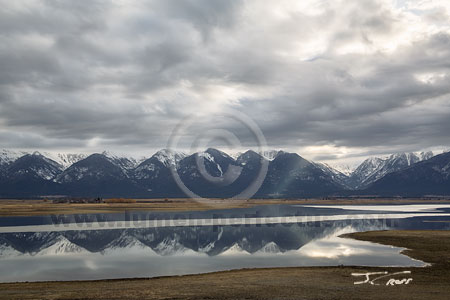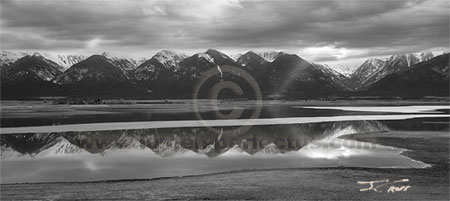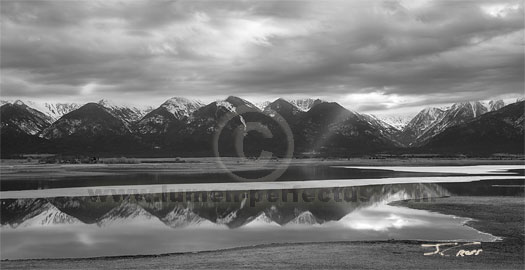www.lumen-perfectus.com
Getting it Right
“Perfection is attained by slow degrees; it requires the hand of time.”
Voltaire
More than once I've written that some photos are easy, while others are not. Some of the easy ones are terrific pictures; I've no complaints when a photo location is easy to reach, the set-up and composition there are simple and obvious, very little post-processing with the computer is required, and the resulting prints look great. It happens, but not frequently. More often each of those stages requires some work, some stages more than others. I enjoy the work and look forward to doing it, especially when, in the end, the final print is clearly worth the effort.
It's trying to be spring here, in late March of 2013. So far it's not succeeding much. It's been cold and mostly cloudy; we get a dusting of snow two or three times a week, and the colors of the sky, landscape, and water have been blah. All typical for this time of year; winter wants to be over, but spring's in no rush to arrive. Except for a few local outings, my photo gear has remained in its backpack.
One of those outings, a visit to Ninepipe National Wildlife Refuge, about 25 miles (40 km) south of home, came earlier in March. The day dawned very cold, and while most of the conditions were just as described above, we had an interesting sky, with big puffy clouds against a blue background. Sunrise did a nice job lighting those clouds, but we managed to get on the road only after the sun had climbed a little higher. A much cloudier sky awaited us at Ninepipe; thanks to those clouds it seemed rather dark and gloomy at 8:00 AM. We watched birds, including several pairs of trumpeter swans, for a while. We drove some of the backroads around the NWR looking for other interesting birds. Mostly we were waiting—waiting for the sky to change, waiting for the light to improve, waiting for blah to become something worth photographing.
Being Lucky
I say it too often, but it's so true: If you can't be good, be lucky. While parked on the earthen dam in the NWR and looking east toward the Mission Mountain range, a tiny hole appeared in the dramatic clouds, perfectly positioned to allow a single beam of sunlight through. Mist on the mountains made the beam quite apparent and it reflected very nicely in the mirror-like surface of the main pond in the NWR. A narrow band of ice broke the glassy water, adding an additional dimension to the scene. With my tripod already set up, the camera mounted and focused, and my composition set, I could hardly believe my luck when the beam appeared. It lasted 30 seconds, and then the hole in the clouds closed, the amazing light gone. Being set up and ready, I had enough time for some single-frame exposures, and also for a few sets of exposures bracketed for use with HDR (high dynamic range) processing. I felt certain I'd need those, the scene's extreme range from highlight to shadow being far beyond what a single exposure could adequately capture.
Post-capture Magic
Using Photoshop I assembled five frames, exposed ±0, +1, +2, -1, and -2 stops, into a single image file. Rather than use Photoshop's HDR Pro for this processing, I used a very interesting technique described in this video by Gavin Hoey. I found the result much more to my liking than the typical HDR-processed image. Now I had a full-frame color image with brilliant highlights and nice grays in the sky, with good detail in the dark mountains and their reflection.

The initial color image
With a perfect sky for it, when shooting the scene I'd imagined a black & white image. The color in the mountains added nothing to the photo, but I liked the contrast with the light beam, and I liked the color of the grassy foreground area. Converting to B&W and then fine-tuning made for a fantastic sky, but I felt the image lost something without the foreground color. I spent too much time, probably, comparing the color and B&W versions. I adjusted saturation in the color version. I tweaked contrast in the B&W version, from moderate to extreme. I even tried toning the black and white version, something I rarely do (and didn't like, in this case). I loved the beam and reflections in this image, but my efforts had so far failed to bring out what I saw and felt when shooting it.
I posted my best color and B&W versions to a site used for review and critique by several photographers I've known for some time. As usual, this generated a few suggestions, some useful, some not. Friend Dean, who has a gift for pointing out the obvious, suggested that the large and dramatic sky had overwhelmed the photo's real subjects, the light beam and reflection. He suggested cropping out some of the sky, giving the image a panoramic aspect ratio. He also confirmed my own opinion about the black and white version; it's the keeper.

The first cropped B&W version
The question then became, how much to crop? I liked the sky—dramatic, powerful, “big”, but clearly overpowering the image. My radical first attempt eliminated most of the sky. I left enough to provide a little breathing room over the mountain range. Dean's insight, right on target as usual, improved the photo. The emphasis shifted from the sky to the light beam and reflection. I looked at this version off-and-on for several days. Clearly better than the original, but still not quite right.
Striving for Perfection
Not quite right, but close. Knowing I was on the right track, I continued to work on the cropping. I spent a very long time with this, making perhaps a dozen different crops, studying that version a while, scrapping it, and then trying again. The final version is shown below. Except for the cropping I made no other changes from the version shown above. I'm now very satisfied with the photo. I have not yet made a print. When I do, I may find the image needs a bit more work, but if so, I expect any adjustments to be quite minor.

The final version
With apologies to Voltaire, perfection isn't achievable; I'm happy if I get it “right”, a close second to perfect. Thanks, Dean. Your insight is always appreciated; this isn't the first time it's improved my photography!
March, 2013
Note: I'm sorry about the big © in the middle of the pictures. I hate doing this, and dislike the mess it makes of the images. But I constantly find my pictures all over the Web, often using my bandwidth to display them. There's very little that can be done to stop this violation of my copyright, but I've found when I insert the watermark, the images are virtually never stolen. Therefore I continue to do this.
All products and brand names mentioned are trademarks or registered trademarks of their respective owners.